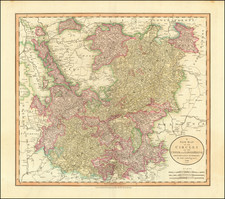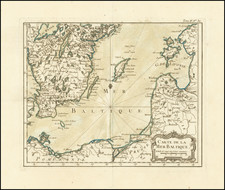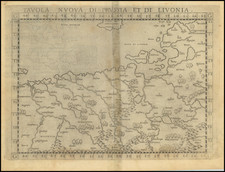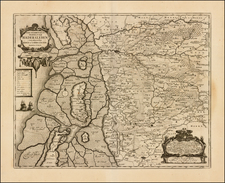Detailed battle plan of Stralsund, showing the commencement of the decisive battle of the Siege of Stralsund (1711-1715) on July 15, 1715.
The map shows the Swedish defenses and the positions of the Dannish led forces and Prussian Army and the Swedish and allied naval positions in great detai, along with annotations and other strategic points of interest.
The Siege of Stralsund was a battle during the Great Northern War. The Swedish Empire defended her Swedish Pomeranian port of Stralsund against a coalition of Denmark-Norway, the Electorate of Saxony and the Tsardom of Russia, which was joined by Brandenburg-Prussia during the siege.
A first attempt to take Stralsund was made in 1711, when the allies closed in on the town. Swedish relief forced the coalition to withdraw from the fortifications, whereupon the besieging armies drew a wider ring along the lines of the Recknitz and Peene rivers. Magnus Stenbock's victory at Gadebusch for a short time distracted the allies, but after Stenbock's pursuit and subsequent defeat, Brandenburg-Prussia as well as Hanover, ruled in personal union with Great Britain, joined the anti-Swedish alliance.
The allies agreed that Denmark should cede her claims to Bremen-Verden to Hanover, and in turn Denmark was promised the northern parts of Swedish Pomerania with Stralsund, while the southern parts were to become Prussian. In 1714, Charles XII of Sweden rode to Stralsund from his Turkish exile to lead the defense in person. From July 12, 1715 to December 24, 1715, the allies sieged the town and eventually forced its surrender. Charles XII escaped to Sweden. Stralsund remained under Danish control until it was returned to Sweden by the Treaty of Frederiksborg.
Johann Baptist Homann (1663-1724) was a mapmaker who founded the famous Homann Heirs publishing company. He lived his entire life in Bavaria, particularly in Nuremberg. Initially, Johann trained to become a priest before converting to Protestantism and working as a notary.
In 1702, Johann founded a publishing house that specialized in engravings. The firm flourished, becoming the leading map publisher in Germany and an important entity in the European map market. In 1715, Johann was named Imperial Geographer to the Holy Roman Empire by Charles VI and made a member of the Prussian Academy of Sciences. Most importantly for his business, his reputation and contacts gained him imperial printing privileges which protected his publications and recommended him to customers. Johann is best known for this Grosser Atlas ueber die ganze Welt, or the Grand Atlas of the World, published in 1716.
After Johann died in 1724, the business passed to his son, Christoph (1703-1730). Upon Christoph’s early death, the company passed to subsequent heirs, with the name of the company changing to Homann Erben, or Homann Heirs. The firm continued in business until 1848.














![Moscovia Parte Orientale . . . [with] Parte Occidentale . . .](https://storage.googleapis.com/raremaps/img/small/26615.jpg)